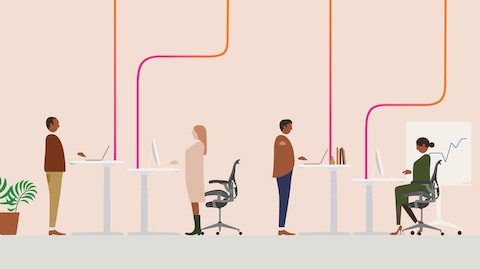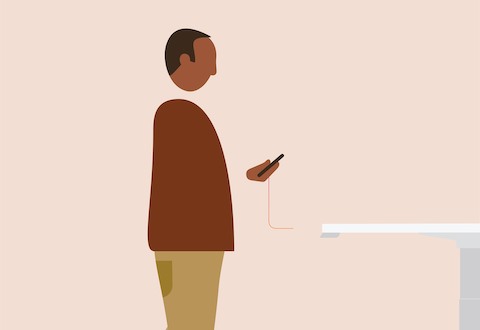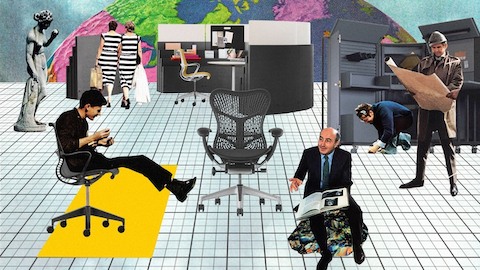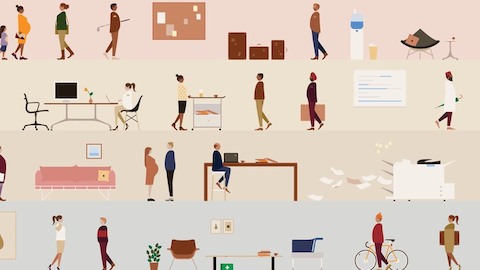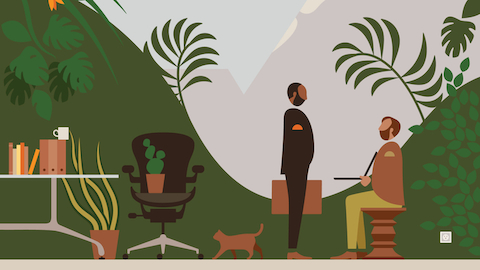In 1946, Charles and Ray Eames designed their iconic Molded Plywood Chair for Herman Miller, two curved pieces of bent ply mounted on a spine and legs. The chair was notable for its simplicity and for its comfort, feats achieved through a molding process that Charles and Ray pioneered when making leg splints during the Second World War. Thus, plywood, the simple, pliable, and affordable material, became the basis for a piece of furniture that Time magazine eventually named the design of the century.
It’s the Eameses’ legacy of material innovation that inspires Christopher Hoyt, who is part of a team focused on making today’s furniture as relevant and quietly intuitive to people today as the Eames Molded Plywood Chair has been for the last 70 years. Just as the Eameses married the materials of their day with the most up-to-date technology they could devise, Hoyt—a design exploration leader at Herman Miller—is hard at work adapting today’s office furniture for a digitally-connected workforce. His team’s molded plywood, however, is information.
“We’re a hundred-year-old company, and we’ve always been involved in technology,” Hoyt says. “The technology of today, however, is digital.”
Products like Nest, the energy-efficient smart thermostat that homeowners control through an app, or Fitbit, a wristband that monitors physical activity, have brought the so-called internet of things into the home and our personal space. In the office however, the kind of smart furniture that Herman Miller is debuting is pitched to benefit both people and organizations alike.
“Herman Miller has been exploring the use of sensors in the work environment since the late 1990s, and we feel that we can improve people’s everyday experiences and provide organizations with data-driven insights,” says Ryan Anderson, director of commercialization and business development for Herman Miller. “If you were to zoom out and say we want to create an ‘internet of things’ approach to the work environment, it would lead you inevitably to the furniture.”
That thinking has led Herman Miller to launch Live OS, a new digital platform designed to personalize and optimize the office for the people who use it. More than sticking sensors on furniture, Live OS offers people and their organizations unprecedented insight into what actually goes on in the office, and a chance to use real data to drive smarter decisions. People will suddenly have the ability to personalize their workspaces, book rooms on the fly, and digitally connect to chairs and tables for a more ergonomic day at the office. The term of art for this brand of user control is “consumerization,” and the market is moving toward this type of intuitive tech solution you don’t need an hour on the phone with IT to use and understand.
According to Valentin Heun, a researcher and PhD student at the MIT Media Lab whose work focuses on connecting digital and physical environments, the key to creating successful smart products lies in improving a person’s understanding of the world around them. “You need to create tools that include the person and gives them the feeling of having the power and being in charge,” Heun says.
The second big benefit of Live OS is that organizations that deploy it will get an unprecedented glimpse into how their facilities are actually used. By applying digital technology to furniture and settings, Live OS will deliver data that companies can utilize to make more informed decisions about one of their biggest assets: the places where their people work. Information is poised to replace intuition as the coin of the realm.
“Real estate tends to be second highest investment for a company after people,” Anderson says. “But data on how the space is actually used is very difficult to get. You need proximity to the user; that requires the furniture.”
A generation ago, companies didn’t have access to the kind of data that Live OS promises—but they also didn’t need it as much. Many employees had no choice but to stay close to their desks for most of the day because that’s where the phone rang and the desktop PC sat. As it happens, Herman Miller played a pivotal, if stealthy, role in the development of the personal computer, a revolution that remade offices the world over. In 1968, in what’s been dubbed “the Mother of All Demos,” technologist Douglas Engelbart debuted a prototype for the personal computer on a hacked-together rig that Herman Miller designer Jack Kelley built from an Eames Shell Chair, jerry-built console, and a small swatch of Naugahyde that was the world’s first mousepad.
Engelbart and Kelley’s inelegant, earthbound command center, may have presaged the desktop-PC-driven workplace, but today’s untethered mobile worker has a different set of needs altogether. And because so much work can now be accomplished digitally, that worker’s employer is looking to make the most effective use of their IRL infrastructure. That means making smarter decisions about space utilization and giving people the flexibility and control over their work experience that they’ve come to expect from their digital devices.
But even in offices that have adopted flexible workspaces, many workers still sit for long periods, which is hardly healthful. Meanwhile, laptops are smaller than ever, causing many people to hunch over them during periods of concentration, exacerbating physical strain. Research shows that adjustable sit-to-stand desks, which are supposed to allow people to change position during the day, often go unused. And not because people don’t want them, but rather because people often don’t understand that the goal is neither sitting, nor standing, but transitioning between the two.
An early example of how Live OS technology will benefit people and their companies is offered by the Renew Live Table which uses built-in sensors and a digital platform to optimize the sit-to-stand experience for the smartphone set. People can personalize their sit and stand settings on the app, which will travel with them to any desk in the office they so choose. They can also opt in for wellness features and set personal activity goals. The product is a subtle enhancement to Herman Miller’s existing Renew Table, and upgrades to products like the Aeron Chair are currently in the works as well.
“In the 1940s, [former Herman Miller design director] George Nelson came up with this concept of the office as a daytime living room,” says Joseph White, Herman Miller’s director of workplace strategy, design, and management. In Nelson’s day, the executive class was most often tasked with creative thinking that a daytime living room affords. But as workplace culture has shifted, and people at all strata of organizations are called upon for creative work, expanding the living room model as widely as possible makes sense.
“The benefit is this notion of being able to feel at home wherever you work,” White says. “If you were to walk up to any place in the environment and it automatically adjusts to receive you, any spot can be your home. There’s a fluid connection throughout the environment. It starts to open up the opportunity for people to stop thinking about their desks, and spend their energy on a higher order of thinking.”
